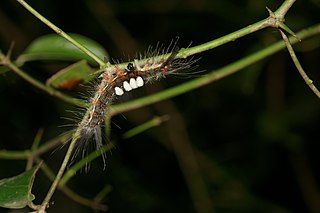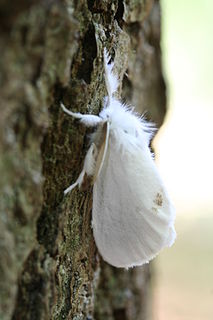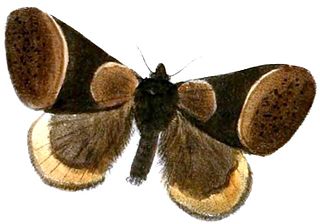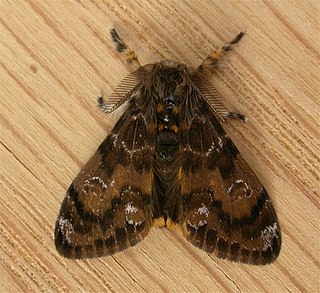
The Lymantriinae are a subfamily of moths of the family Erebidae. The taxon was erected by George Hampson in 1893.

The yellow-tail, goldtail moth or swan moth is a moth of the family Erebidae. The species was first described by Johann Kaspar Füssli in 1775, and has commonly been placed within the related genus Euproctis. It is distributed throughout Europe to the Urals, then east across the Palearctic to Siberia and south to India and Sri Lanka.

Autoba is a genus of moths of the family Erebidae. The genus was erected by Francis Walker in 1863.
Cifuna is a genus of tussock moths in the family Erebidae. The genus was erected by Francis Walker in 1855.
Clethrogyna is a genus of tussock moths in the family Erebidae. The genus was described by Rambur in 1866.

Daplasa is a genus of moths in the subfamily Lymantriinae of the family Erebidae erected by Frederic Moore in 1879. It is the sole member of the tribe Daplasini erected Jeremy Daniel Holloway and Houshuai Wang in 2015.

Euproctis is a genus of tussock moths in the family Erebidae described by Jacob Hübner in 1819. Species are cosmopolitan, widespread throughout Palearctic, African, Oriental and Australian regions. Molecular phylogenetic studies indicate that the genus as presently understood comprises a large number of unrelated lineages, only a few of which have names, and is therefore in serious need of revision.
Griveaudyria is a genus of tussock moths in the family Erebidae.

Heracula is a genus of moths in the family Pseudobistonidae. It contains only one species, Heracula discivitta, which is found in India (Sikkim) and Nepal.

Pida is a genus of moths in the subfamily Lymantriinae. The genus was erected by Francis Walker in 1865, and including members of the former genus Ramadra.

Teia is a genus of tussock moths in the family Erebidae first described by Francis Walker in 1855.
Telochurus is a genus of tussock moths in the family Erebidae erected by Koen V. N. Maes in 1984.

Arctornis jonasii is a moth in the family Erebidae, originally placed in its own genus, Topomesoides, which was synonymized with Arctornis in 2015. It was first described by Arthur Gardiner Butler in 1877.

Asota is a genus of moths in the family Erebidae first described by Jacob Hübner in 1819. Species are widely distributed throughout Africa, India, Sri Lanka, Myanmar, the Malayan region and tropical parts of the Australian region.

Telochurus recens, the scarce vapourer, is a moth of the subfamily Lymantriinae found in Europe. The species was first described by Jacob Hübner in 1819. The wingspan is 35 to 40 millimetres (1.4–1.6 in) for the males; the females are wingless. The moth flies from June to July depending on the location. The larvae feed on various deciduous trees, such as Crataegus and Salix species. This species has commonly been placed in the genus Orgyia but molecular analyses support its exclusion from that genus, and placement in the genus Telochurus.

The Erebidae are a family of moths in the superfamily Noctuoidea. The family is among the largest families of moths by species count and contains a wide variety of well-known macromoth groups. The family includes the underwings (Catocala); litter moths (Herminiinae); tiger, lichen, and wasp moths (Arctiinae); tussock moths (Lymantriinae), including the arctic woolly bear moth ; piercing moths ; micronoctuoid moths (Micronoctuini); snout moths (Hypeninae); and zales, though many of these common names can also refer to moths outside the Erebidae. Some of the erebid moths are called owlets.

Clethrogyna antiquoides is a moth of the family Erebidae. It is found in most of Europe, the Ural, Armenia, Mongolia, and China. This species has commonly been placed in the genus Orgyia but molecular analyses support the genus Clethrogyna as a separate lineage.

Clethrogyna aurolimbata is a species of moth of the family Erebidae first described by Achille Guenée in 1835. It is found in the Pyrenees and on the Iberian Peninsula. The larvae feed on Genista species, including Genista purgans. This species has commonly been placed in the genus Orgyia but molecular analyses support the genus Clethrogyna as a separate lineage.
Kidokuga is a genus of tussock moths in the family Erebidae. The genus was erected by Yasunori Kishida in 2010. It is considered a synonym of the related genus Euproctis by some authors, but recognized as valid by others (e.g.), and supported as distinct in molecular phylogenetic studies.
Kuromondokuga is a genus of tussock moths in the family Erebidae erected by Yasunori Kishida in 2011.














